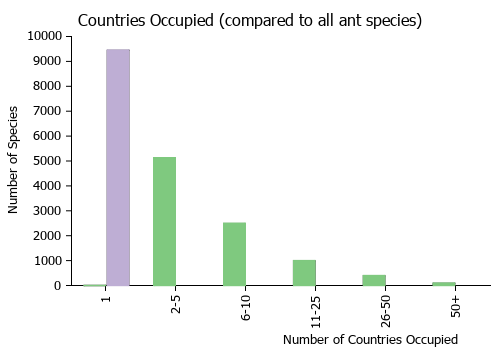Strumigenys philiporum
| Strumigenys philiporum | |
|---|---|

| |
| Scientific classification | |
| Kingdom: | Animalia |
| Phylum: | Arthropoda |
| Class: | Insecta |
| Order: | Hymenoptera |
| Family: | Formicidae |
| Subfamily: | Myrmicinae |
| Tribe: | Attini |
| Genus: | Strumigenys |
| Species: | S. philiporum |
| Binomial name | |
| Strumigenys philiporum Brown, 1988 | |
Specimens have been taken from rainforest, with some noted as being found in rotten logs.
Identification
Bolton (2000) - A member of the Strumigenys mayri-group. Perhaps the most immediately recognisable Strumigenys species in the Austral region; the massive overdevelopment of spongiform tissue renders philiporum unmistakable. Two other species from the Malesian region show a similar hypertrophy of spongiform tissue on the alitrunk, Strumigenys sisyrata and Strumigenys kempfi, but these cannot be confused with philiporum (see their respective descriptions). The reason for this strange adaptation remains unguessed.
Keys including this Species
Distribution
Latitudinal Distribution Pattern
Latitudinal Range: -16.52° to -19.00261633°.
| North Temperate |
North Subtropical |
Tropical | South Subtropical |
South Temperate |
- Source: AntMaps
Distribution based on Regional Taxon Lists
Australasian Region: Australia (type locality).
Distribution based on AntMaps
Distribution based on AntWeb specimens
Check data from AntWeb
Countries Occupied
| Number of countries occupied by this species based on AntWiki Regional Taxon Lists. In general, fewer countries occupied indicates a narrower range, while more countries indicates a more widespread species. |

|
Estimated Abundance
| Relative abundance based on number of AntMaps records per species (this species within the purple bar). Fewer records (to the left) indicates a less abundant/encountered species while more records (to the right) indicates more abundant/encountered species. |

|
Biology
Castes
Images from AntWeb
 
| |
| Paratype of Strumigenys philiporum. Worker. Specimen code casent0900915. Photographer Will Ericson, uploaded by California Academy of Sciences. | Owned by NHMUK, London, UK. |
Nomenclature
The following information is derived from Barry Bolton's Online Catalogue of the Ants of the World.
- philiporum. Strumigenys philiporum Brown, 1988b: 38, fig. 1 (w.) AUSTRALIA. See also: Bolton, 2000: 981.
Unless otherwise noted the text for the remainder of this section is reported from the publication that includes the original description.
Description
Worker
Bolton (2000) - TL 2.9-3.3, HL 0.78-0.86, HW 0.46-0.51, CI 58-60, ML 0.36-0.40, MI 43-49, SL 0.50-0.60, SI 110-118, PW 0.32-0.39, AL 0.80-0.95 (20 measured).
Spongiform tissue massively hypertrophied. As well as the usual spongiform lobes on the waist segments there is a crest on the dorsum of the petiole peduncle and a huge development of spongiform tissue on the alitrunk. In profile the entire dorsum of the mesonotum and propodeum, the entire side and declivity of the propodeum and most of the metapleuron, is covered with a single continuous blanket of dense spongiform tissue; only the pronotal dorsum is free of it. In dorsal view there is a V-shaped cleft in the tissue above the propodeal declivity and another, much smaller, gap in the tissue above the anterior mesonotum. In profile and dorsal view the thick lateral spongiform lobe of the petiole extends the entire length of the node. Eyes large, maximum diameter very obviously greater than maximum width of scape; with about 7 ommatidia in the longest row and more than 20 in total. Pronotum sharply marginate dorsolaterally, the dorsum flat to shallowly concave. Apicoscrobal hair flagellate; pronotal humeral hair flagellate and pronotal dorsum with two erect flagellate pairs. Erect flagellate hairs also present on waist segments, gaster and all segments of legs. Cephalic dorsum with a transverse row of erect simple hairs across occipital margin, with a pair of similar hairs at highest point of vertex and another pair between this and the occipital row. Sides of alitrunk that are free of spongiform tissue glassy smooth. Disc of postpetiole sculptured, with some weak transverse striolae developed.
Type Material
Bolton (2000) - Holotype worker, paratype workers and queen, AUSTRALIA: Queensland, Mt Lewis, near Mossman, 900 m, 26.xii.1957 (P. J. & P. S. Darlington); paratype workers, AUSTRALIA: Queensland, Mt Alexander, NW of Daintree, 20-23.xii.1957, rainforest (Darlingtons); Qld, Lake Eacham, Atherton Tableland, ii.1958, rainforest (Darlingtons); Lake Eacham Nat. Pk, nos. 1423, 1603, rotten logs (R. W. Taylor); Danbullah Forest, near Atherton, no. 1662 (R. W. Taylor) (Museum of Comparative Zoology, Australian National Insect Collection, The Natural History Museum) [examined].
- Holotype, worker, Mt. Lewis, near Mossman, Queensland, Australia, Museum of Comparative Zoology.
- Paratype, 2 workers, Danbullah Forest near Atherton [Danbulla Forest Reserve], Queensland, Australia, Taylor,R., ANIC32-017794, Australian National Insect Collection.
- Paratype, 1 worker, Lake Eacham, Queensland, Australia, Taylor,R.W., ANIC32-017795, Australian National Insect Collection.
- Paratype, 2 workers, Lake Eacham, Atherton Tableland, Queensland, Australia, Darlingtons, ANIC32-017796, Australian National Insect Collection.
- Paratype, 3 workers, Mt. Alexander, NW Daintree, Queensland, Australia, Darlington,P.F., ANIC32-017797, Australian National Insect Collection.
- Paratype, 6 workers, Mt. Lewis via Mossman, Queensland, Australia, Darlingtons, ANIC32-017798, Australian National Insect Collection.
- Paratype, worker(s), Mt. Alexander, Lake Eacham or Danbullah Forest, Queensland, Australia, The Natural History Museum.
References
- Bolton, B. 2000. The ant tribe Dacetini. Memoirs of the American Entomological Institute. 65:1-1028. (page 981, figs. 534, 540 redescription of worker)
- Brown, W. L., Jr. 1988b. Strumigenys philiporum species nov. Pilot Regist. Zool. Card No. 38.
- Wang, C., Chung, F.-Y., Lin, C.-C., Gibson, J. C., McGuire, S., Suarez, A. V., Billen, J. 2023. The spongiform tissue in Strumigenys ants contains exocrine glands. Arthropod Structure & Development 73, 101246 (doi:10.1016/j.asd.2023.101246).
References based on Global Ant Biodiversity Informatics
- Bolton, B. 2000. The Ant Tribe Dacetini. Memoirs of the American Entomological Institute 65
- Brown W. L., Jr. 1988. Strumigenys philiporum species nov. Pilot Regist. Zool. Card No. 38.
- King J. R., A. N. Andersen, and A. D. Cutter. 1998. Ants as bioindicators of habitat disturbance: validation of the functional goup model for Australi's humid tropics. Biodiversity and Conservation 7: 1627-1638.

